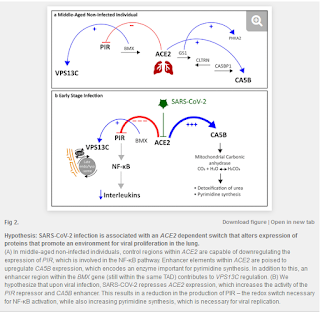what happens in the gonads does not stay in the gonads - brief notes
Protein aggregates in nematode worm gonads set off the mitochondrial unfolded protein response (UPRmt) that propagates throughout the organism via Wnt signalling, causing changes in mitochondrial function and potentially increasing protein aggregation in distal tissues. It is not known if this happens in mammals.
advances.sciencemag.org/con...
This news might not be such a big deal as it has already been reported that Wnt signalling is altered in post-menopausal women due to loss of estrogen and rates of neurodegeneration increase after menopause. However, it would be interesting to know whether in mammals insults (possibly caused by infection) to the ovaries earlier in life (and testes?) may propagate the UPRmt throughout the body.
~
If UPRmt is meant to counter stress and clean up misfolded proteins, then why would increasing it be bad? It may actually be good, but there have been conflicting findings, which are reviewed here:
The mitochondrial unfolded protein response and increased longevity: Cause, consequence, or correlation? (2014) - https://www.ncbi.nlm.nih.gov/pmc/articles/PMC4048780/pdf/nihms569971.pdf
More recent research articles on the topic:
Proteasome activity contributes to pro-survival response upon mild mitochondrial stress in Caenorhabditis elegans (2021) - https://pubmed.ncbi.nlm.nih.gov/34252079/
Early-life mitochondrial DNA damage results in lifelong deficits in energy production mediated by redox signaling in Caenorhabditis elegans (2021) - https://www.sciencedirect.com/science/article/pii/S2213231721001580Dietary thiols accelerate aging of C. elegans (2021) - https://www.nature.com/articles/s41467-021-24634-3
~
A yeast study on thiol availability, iron homeostasis and age-related decline in mitochondrial function:
Cysteine Toxicity Drives Age-Related Mitochondrial Decline by Altering Iron Homeostasis (2020) - https://pubmed.ncbi.nlm.nih.gov/31978346/
"Among amino acids, we find that cysteine is most toxic for mitochondria
and show that elevated non-vacuolar cysteine impairs mitochondrial
respiration by limiting intracellular iron availability through an
oxidant-based mechanism. Cysteine depletion or iron supplementation
restores mitochondrial health in vacuole-impaired cells and prevents
mitochondrial decline during aging. These results demonstrate that
cysteine toxicity is a major driver of age-related mitochondrial
deterioration and identify vacuolar amino acid compartmentation as a
cellular strategy to minimize amino acid toxicity. ...
High doses of proton pump inhibitors can inhibit V-ATPase.
~
It is likely the case that, as with so many things, it is the ability to induce as needed and turn off when not that is important.
There appear to be different responses when stress is applied early in life vs. late. It would be interesting to know if there is a morbidity-mortality paradox.

Comments
Post a Comment